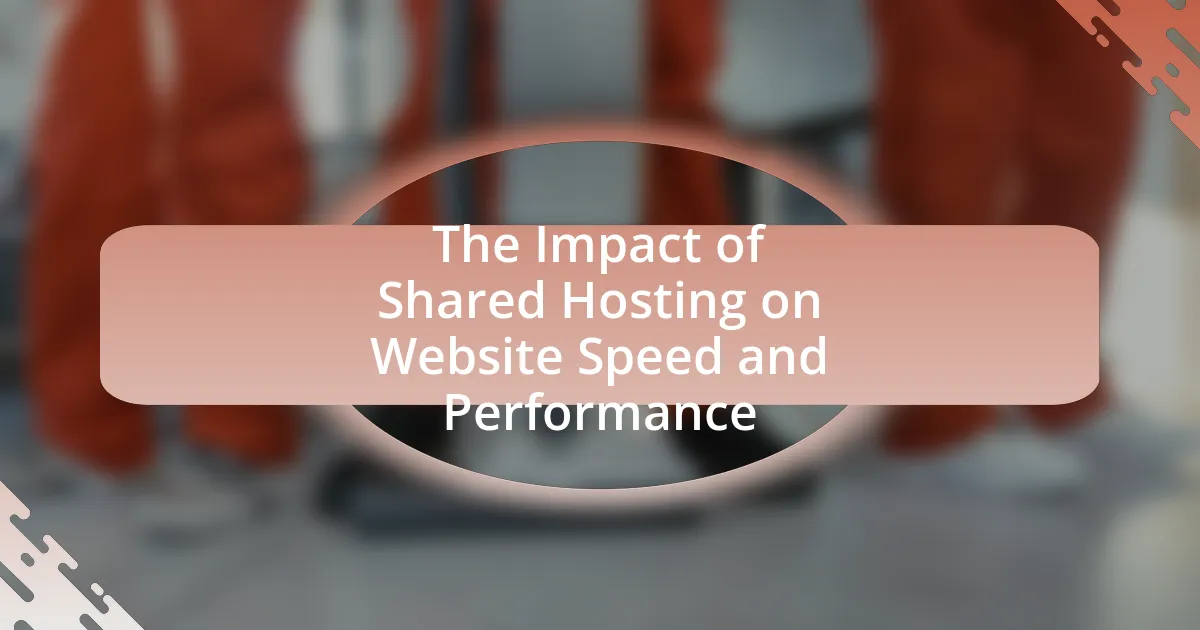Shared hosting significantly impacts website speed and performance due to resource limitations, as multiple websites share the same server resources, including CPU, RAM, and bandwidth. This environment can lead to slower loading times, particularly during peak traffic periods, with studies indicating that shared hosting can result in loading times up to 50% slower than dedicated servers. Factors contributing to these performance issues include server congestion, inadequate resource allocation, and the activities of other websites on the same server. Additionally, website speed is crucial for user experience and search engine rankings, with slow loading times leading to higher bounce rates and decreased conversions. The article also explores alternatives to shared hosting, optimization strategies for users, and the long-term implications of using shared hosting on website scalability and performance.

What is the Impact of Shared Hosting on Website Speed and Performance?
Shared hosting negatively impacts website speed and performance due to resource limitations. In shared hosting environments, multiple websites share the same server resources, including CPU, RAM, and bandwidth. This can lead to slower loading times, especially during peak traffic periods when resources are stretched thin. For instance, a study by HostingAdvice found that websites on shared hosting can experience loading times that are 50% slower compared to those on dedicated servers. Additionally, the performance can be further affected by the activities of other websites on the same server, as high traffic or resource-intensive processes from one site can slow down others.
How does shared hosting influence website loading times?
Shared hosting typically slows down website loading times due to resource sharing among multiple users on the same server. When many websites share the same server resources, such as CPU, RAM, and bandwidth, the performance can degrade, especially during peak traffic times. Research indicates that websites on shared hosting can experience slower response times, with studies showing that loading times can increase by up to 50% compared to dedicated hosting environments. This is primarily because the server’s resources are divided among all hosted sites, leading to potential bottlenecks and increased latency.
What factors in shared hosting contribute to slower speeds?
Shared hosting contributes to slower speeds primarily due to resource limitations, server congestion, and lack of dedicated resources. In shared hosting environments, multiple websites share the same server resources, including CPU, RAM, and bandwidth. This sharing can lead to performance degradation, especially during peak traffic times when many sites are active simultaneously. Additionally, if one website experiences a surge in traffic or consumes excessive resources, it can negatively impact the loading times of all other sites on the same server. Studies indicate that shared hosting can result in slower response times, with some reports showing that websites on shared hosting can be up to 50% slower compared to those on dedicated servers.
How does server resource allocation affect performance?
Server resource allocation directly impacts performance by determining the availability of CPU, memory, and bandwidth for applications. When resources are allocated efficiently, applications can run smoothly, leading to faster response times and improved user experience. Conversely, inadequate resource allocation can cause bottlenecks, resulting in slower load times and potential downtime. For instance, a study by Google found that a one-second delay in page load time can lead to a 20% decrease in conversions, highlighting the critical role of resource allocation in maintaining optimal performance.
Why is website speed important for user experience?
Website speed is crucial for user experience because it directly affects user satisfaction and engagement. Research indicates that a one-second delay in page load time can lead to a 7% reduction in conversions, as users are likely to abandon slow-loading sites. Additionally, Google reports that 53% of mobile users will leave a page that takes longer than three seconds to load. Faster websites enhance user retention, improve search engine rankings, and increase overall site usability, making speed a vital component of effective web design and hosting strategies.
What are the consequences of slow loading times on user engagement?
Slow loading times significantly decrease user engagement. Research indicates that 40% of users abandon a website that takes more than three seconds to load, leading to higher bounce rates and reduced time spent on the site. Additionally, slow loading times can negatively impact conversion rates; for instance, a one-second delay in page response can result in a 7% reduction in conversions, as reported by Akamai. This decline in user engagement can ultimately harm a website’s reputation and its ability to retain visitors.
How does website speed impact search engine rankings?
Website speed significantly impacts search engine rankings, as search engines prioritize user experience. Faster-loading websites tend to rank higher because they reduce bounce rates and increase user engagement. According to Google, a delay of just one second in page load time can lead to a 20% decrease in conversions, indicating that speed directly influences user behavior and satisfaction. Additionally, studies show that Google uses page speed as a ranking factor in its algorithms, reinforcing the importance of optimizing website speed for better visibility in search results.
What are the common performance issues associated with shared hosting?
Common performance issues associated with shared hosting include limited resources, slower load times, and reduced reliability. In shared hosting environments, multiple websites share the same server resources, which can lead to resource contention. For instance, if one website experiences a traffic spike, it can consume a disproportionate amount of CPU and memory, negatively impacting the performance of other sites on the same server. Additionally, shared hosting often results in slower load times due to the limited bandwidth allocated to each user, which can affect user experience and search engine rankings. Furthermore, shared hosting can lead to reduced reliability, as server downtime or maintenance affects all websites hosted on that server, making it difficult for individual sites to maintain consistent uptime.
How does traffic fluctuation affect shared hosting performance?
Traffic fluctuation negatively affects shared hosting performance by causing resource contention among multiple users on the same server. When traffic spikes occur, the limited CPU, RAM, and bandwidth resources are divided among all hosted websites, leading to slower load times and potential downtime. Studies indicate that websites on shared hosting can experience up to a 50% decrease in performance during peak traffic periods due to these resource limitations. This performance degradation can result in higher bounce rates and lower user satisfaction, ultimately impacting the website’s effectiveness.
What role does server location play in website speed?
Server location significantly affects website speed by determining the physical distance between the server and the user. When a server is closer to the user, data travels a shorter distance, resulting in faster loading times. For instance, studies show that reducing latency by just 100 milliseconds can improve conversion rates by 1%. Additionally, content delivery networks (CDNs) utilize multiple server locations to cache content closer to users, further enhancing speed and performance. Therefore, the geographical positioning of servers is crucial for optimizing website speed and user experience.
How can shared hosting users optimize their website performance?
Shared hosting users can optimize their website performance by implementing caching mechanisms, optimizing images, and minimizing HTTP requests. Caching reduces the load on the server by storing frequently accessed data, which can significantly speed up page load times. For instance, using tools like Varnish or browser caching can enhance performance. Optimizing images involves compressing them without losing quality, which decreases load times; studies show that image optimization can reduce page size by up to 80%. Minimizing HTTP requests by combining CSS and JavaScript files can also lead to faster loading, as each request adds latency. These strategies collectively improve website speed and performance, crucial for user experience and search engine rankings.
What best practices can improve loading times on shared hosting?
To improve loading times on shared hosting, optimizing website assets is essential. This includes compressing images, minifying CSS and JavaScript files, and leveraging browser caching. For instance, using tools like Google PageSpeed Insights can identify specific areas for optimization, leading to faster load times. Additionally, implementing a Content Delivery Network (CDN) can distribute content across multiple servers, reducing latency and improving access speed for users globally. According to a study by Akamai, a 100-millisecond delay in website load time can decrease conversion rates by 7%. Therefore, these best practices can significantly enhance performance on shared hosting environments.
How can caching solutions enhance website speed?
Caching solutions enhance website speed by storing frequently accessed data in a temporary storage location, allowing for quicker retrieval. This reduces the time needed to fetch data from the original source, which can be slower due to server load or network latency. For example, a study by Google found that using caching can improve page load times by up to 90%, significantly enhancing user experience and reducing bounce rates. By minimizing database queries and server processing time, caching solutions effectively optimize website performance, particularly in shared hosting environments where resources are limited.

What are the alternatives to shared hosting for better performance?
The alternatives to shared hosting for better performance include Virtual Private Servers (VPS), dedicated servers, cloud hosting, and managed WordPress hosting. VPS provides a dedicated portion of server resources, enhancing performance compared to shared hosting, as evidenced by improved load times and reliability. Dedicated servers offer complete control and maximum resources, ideal for high-traffic websites, which can lead to significantly faster response times. Cloud hosting utilizes multiple servers to balance loads and ensure uptime, resulting in scalable performance. Managed WordPress hosting optimizes server configurations specifically for WordPress sites, leading to faster speeds and better security. Each of these alternatives addresses the limitations of shared hosting, providing enhanced performance for websites.
How does VPS hosting compare to shared hosting in terms of speed?
VPS hosting generally offers faster speeds compared to shared hosting. This speed advantage arises because VPS hosting allocates dedicated resources to each user, such as CPU, RAM, and bandwidth, which are not shared with other users. In contrast, shared hosting distributes resources among multiple users, leading to potential slowdowns, especially during peak traffic times. Studies indicate that websites on VPS can load up to 30% faster than those on shared hosting due to these dedicated resources and reduced contention for bandwidth.
What are the benefits of dedicated hosting for performance?
Dedicated hosting significantly enhances performance by providing exclusive access to server resources. This exclusivity eliminates resource contention, allowing websites to load faster and handle higher traffic volumes without degradation in speed. Additionally, dedicated hosting offers customizable configurations, enabling optimization for specific applications and workloads, which further boosts performance. According to a study by HostingAdvice, dedicated servers can improve website loading times by up to 50% compared to shared hosting environments, demonstrating the tangible benefits of dedicated hosting for performance.
How does cloud hosting improve website speed and reliability?
Cloud hosting improves website speed and reliability by utilizing a network of interconnected servers that distribute resources efficiently. This architecture allows for load balancing, which ensures that traffic spikes are managed effectively, reducing downtime and enhancing performance. According to a study by Google, websites that load within five seconds have a 70% longer average session duration compared to those that take longer, highlighting the importance of speed in user engagement. Additionally, cloud hosting offers redundancy; if one server fails, others can take over, ensuring continuous availability and reliability. This capability is supported by data from the Cloud Standards Customer Council, which indicates that cloud services can achieve 99.99% uptime, significantly enhancing reliability compared to traditional hosting solutions.
What factors should be considered when choosing a hosting plan for speed?
When choosing a hosting plan for speed, factors such as server location, resource allocation, and technology used should be considered. Server location affects latency; closer servers reduce the time it takes for data to travel. Resource allocation, including CPU, RAM, and bandwidth, determines how much traffic the server can handle efficiently. Additionally, the technology used, such as SSD storage versus traditional HDD, significantly impacts data retrieval speeds. Research indicates that websites hosted on SSDs can load up to 300% faster than those on HDDs, highlighting the importance of these factors in optimizing website speed and performance.
How do bandwidth and storage options affect website performance?
Bandwidth and storage options significantly impact website performance by determining the speed at which data is transmitted and the amount of content that can be stored and accessed. Higher bandwidth allows for faster data transfer, which reduces loading times and enhances user experience; for instance, a website with 100 Mbps bandwidth can handle more simultaneous users compared to one with 10 Mbps. Additionally, adequate storage ensures that all necessary files, such as images and scripts, are readily available, preventing delays caused by data retrieval. Research indicates that websites with optimized bandwidth and sufficient storage can load up to 50% faster, leading to improved user engagement and lower bounce rates.
What role do customer support and uptime guarantees play in hosting choices?
Customer support and uptime guarantees are critical factors in hosting choices, as they directly influence website reliability and user experience. Effective customer support ensures that technical issues are resolved promptly, minimizing downtime and maintaining website performance. Uptime guarantees, typically expressed as a percentage, indicate the reliability of the hosting service; for instance, a 99.9% uptime guarantee means that the website is expected to be operational almost all the time, which is essential for maintaining user trust and engagement. Research shows that websites with higher uptime rates experience better traffic and conversion rates, reinforcing the importance of these factors in hosting decisions.

What are the long-term implications of using shared hosting on website performance?
Using shared hosting can lead to long-term performance issues for websites due to resource limitations and potential overcrowding on servers. Websites hosted on shared servers often compete for CPU, memory, and bandwidth with other sites, which can result in slower load times and decreased reliability as traffic increases. Research indicates that websites with load times exceeding three seconds can experience a 40% increase in bounce rates, negatively impacting user experience and SEO rankings. Additionally, as a website grows, the limitations of shared hosting can hinder scalability, making it difficult to accommodate increased traffic without migrating to a more robust hosting solution.
How can shared hosting impact website scalability over time?
Shared hosting can significantly limit website scalability over time due to resource constraints. In a shared hosting environment, multiple websites share the same server resources, such as CPU, RAM, and bandwidth. As a website grows and experiences increased traffic, the limited resources can lead to slower performance, downtime, and an inability to handle peak loads effectively. For instance, a study by HostingAdvice found that websites on shared hosting can experience up to 50% slower load times compared to those on dedicated servers, particularly during high traffic periods. This limitation can hinder a website’s growth and user experience, making it essential for businesses anticipating growth to consider more scalable hosting solutions.
What challenges might arise as a website grows on shared hosting?
As a website grows on shared hosting, challenges such as limited resources, performance degradation, and security vulnerabilities may arise. Shared hosting environments allocate a finite amount of CPU, memory, and bandwidth among multiple users, leading to potential slowdowns as traffic increases. For instance, if one website on the server experiences a traffic spike, it can consume excessive resources, negatively impacting the performance of other sites. Additionally, shared hosting often lacks robust security measures, making websites more susceptible to attacks, especially as they gain more visibility. According to a study by HostingAdvice, 70% of shared hosting users reported performance issues as their websites scaled, highlighting the direct correlation between growth and resource limitations in shared environments.
How can businesses prepare for future performance needs?
Businesses can prepare for future performance needs by adopting scalable hosting solutions that can accommodate increased traffic and resource demands. Implementing shared hosting plans with flexible upgrade options allows businesses to adjust their resources as needed, ensuring optimal website speed and performance. According to a study by HostingAdvice, 70% of businesses that utilized scalable hosting experienced improved performance during traffic spikes, demonstrating the effectiveness of this approach. Additionally, regularly monitoring website analytics can help businesses anticipate performance needs and make informed decisions about resource allocation.
What practical tips can help users maximize shared hosting performance?
To maximize shared hosting performance, users should optimize their website by minimizing file sizes, utilizing caching, and choosing lightweight themes. Reducing file sizes through image compression and minifying CSS and JavaScript can significantly decrease load times, as studies show that a 1-second delay in page response can result in a 7% reduction in conversions. Implementing caching mechanisms, such as browser caching and server-side caching, can enhance speed by storing frequently accessed data, which reduces server load. Additionally, selecting lightweight themes and plugins ensures that the website runs efficiently, as bloated themes can slow down performance.
How can regular maintenance improve website speed on shared hosting?
Regular maintenance can significantly improve website speed on shared hosting by optimizing resource usage and ensuring that the server operates efficiently. This includes tasks such as updating software, cleaning up databases, and removing unnecessary files, which can reduce load times and enhance performance. For instance, a study by Google found that a one-second delay in loading time can lead to a 20% decrease in conversion rates, highlighting the importance of maintaining optimal speed. Additionally, regular maintenance helps prevent issues like server overload, which is common in shared hosting environments where multiple websites share the same resources. By proactively managing these factors, website owners can ensure faster loading times and a better user experience.
What tools can be used to monitor and enhance website performance?
Tools that can be used to monitor and enhance website performance include Google PageSpeed Insights, GTmetrix, and Pingdom. Google PageSpeed Insights analyzes the content of a web page and provides suggestions to improve its performance, offering a score based on various metrics. GTmetrix combines Google Lighthouse and WebPageTest to provide detailed reports on page load times and performance scores, along with recommendations for optimization. Pingdom offers real-time monitoring and performance insights, allowing users to track uptime and response times. These tools are widely recognized in the industry for their effectiveness in identifying performance issues and suggesting enhancements.


